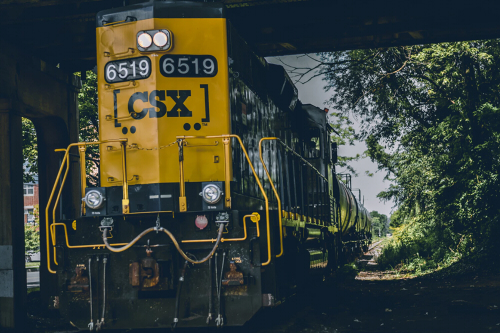Betting Big on the Nation’s Rails
Morgan Brennan
CSX’s northwest Ohio intermodal container transfer facility is surprisingly quiet.
Tucked among soybean and corn fields, the 500-acre North Baltimore site processes nearly 2,500 containers a day, with 33 trains leaving the terminal daily headed for any of one of 110 North American markets.
Seven massive electric cranes glide back and forth, plucking 20-foot equivalent container units (TEUs) from stacks and placing them two-high atop rail cars. With 250 containers lining the terminal, it’s a smorgasbord of shipping and logistics logos, including Maersk, CMA CGM, Schneider, J.B. Hunt and Matson.
CSX opened this one-of-a-kind hub in 2011, and since then it’s been expanded – part of a big bet by the U.S.’s third-largest freight rail carrier that intermodal business will continue to grow and with it the need for more infrastructure.
Intermodal containers can be used to transport goods by ship, truck and rail, the majority stocked with products destined for consumers. Intermodal has been a growing part of the Class I rail carriers’ business, with overall volume increasing by more than a third since 2009, according to the Association of American Railroads, now accounting for nearly half of all freight rail traffic.
As coal continues its years long decline, this business has become a key way to help offset that. It’s why CSX is spending hundreds of millions of dollars on infrastructure to boost capacity throughout its network, with certain projects specifically focused on intermodal.
“We think there is going to be a significant increase in freight demand,” said Louis Renjel, vice president of strategic infrastructure at CSX. “East Coast ports are booming. The population is growing so we are increasing that line and terminal capacity in order to handle that projected demand.”
Take the Virginia Avenue Tunnel, a $400 million project CSX broke ground on in May. CSX is looking to quadruple capacity in the 110-year-old single-lane freight rail tunnel, which extends one mile underneath the heart of Washington, D.C. A second lane will be added, to allow two trains to pass at the same time, cutting down on congestion, which at times has rippled out to passenger railroads operating in the area as well.

Meanwhile, the tracks will be lowered and the clearance of the tunnel lifted to accommodate trains double-stacked with containers (currently only single-stacked intermodal trains can fit).
The most challenging part of this engineering feat: it all must be pulled off while the tunnel continues to allow some two dozen trains to pass per day.
“When we finish this tunnel we will be able to move 280 trucks on a single train – so it’s a lot of highway congestion we are going to alleviate,” said CSX’s Renjel, walking along the tunnel entrance turned construction zone.
The Virginia Avenue Tunnel is a keystone project in the broader $850 million National Gateway initiative, a public-private partnership between CSX, six states and the nation’s capital. National Gateway is a multiphase, 11-year undertaking to move more freight between East Coast ports and the Midwest, double-tracking existing routes and boosting clearance for tunnels and bridges. Seven of those years alone have been dedicated to permitting and complying with regulations.
Once complete in late 2018, CSX is betting all the National Gateway work will result in the conversion of more than 14 billion truck miles to rail, and help save some 2 billion gallons of fuel in the process.
“Intermodal has been traditionally a very strong growth area for the railroads and it continues to be over the very long run,” said Christian Wetherbee, a transportation analyst at Citigroup. “When you think about the United States transportation infrastructure, the rails really are very well-positioned to continue to take market share off of the trucks and onto the rails.”
In the shorter term, fuel prices have been weighing on that conversion since lower diesel costs make trucks more competitive with rail over longer distances. “With low fuel prices you end up having a little bit of a more challenging dynamic in terms of converting this intermodal freight – but it will be growing better than the overall carload base,” said Wetherbee.
Over the long run, the rail industry expects to continue pulling market share from trucks, as trucking capacity tightens amid a driver shortage and tougher regulations for that industry.
That’s why other freight rail carriers are pouring money into intermodal as well. Wetherbee notes one-third of the major rail carriers’ overall capital spending is dedicated to “growth” capital expenditures and the lion’s share of that is targeting intermodal infrastructure.
Last year Union Pacific completed a $400 million intermodal ramp in Santa Teresa, New Mexico. The facility, which can “lift” 225,000 containers per year, is located on the Sunset Route, moving cargo between the Los Angeles-area ports, Texas and the Midwest. Union Pacific opened the facility in spring of 2014 – roughly a year ahead of schedule.
Berkshire Hathaway-owned BNSF has seven intermodal facility expansions on the books for 2015, under its massive $6 billion capital plan.
Norfolk Southern has a proposed $34 million expansion in the works at its Rickenbacker terminal in Columbus, Ohio, as well. The prospective project would entail a public-private partnership between the railroad and Columbus Regional Airport Authority, to boost capacity between Norfolk, Virginia, home to one of the largest ports on the East Coast and Detroit and Chicago.








